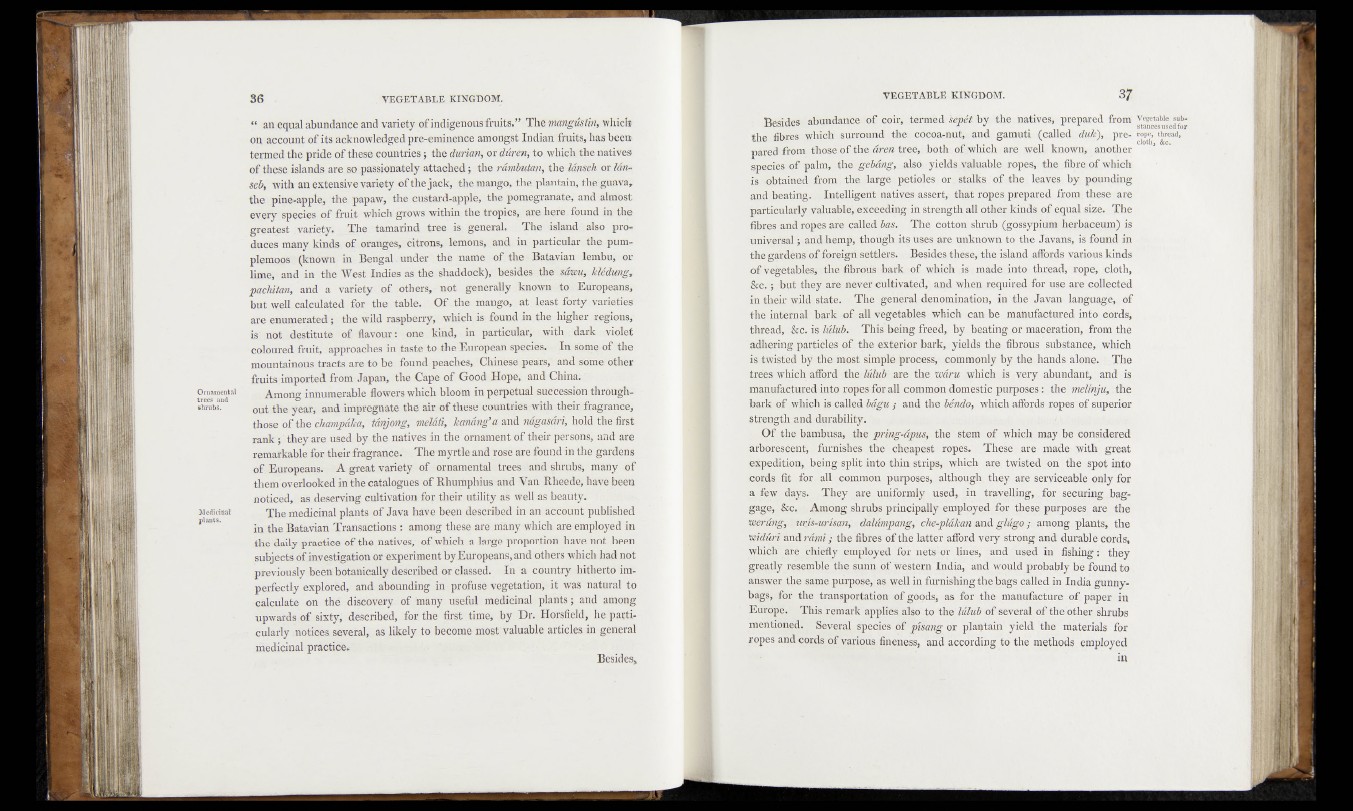
Ornamental
trees and: .gtelbs.
Medicinal
plants.
“ an equal abundance and variety of indigenous fruits.” The mang'âstin, which
on account of its acknowledged pre-eminence amongst Indian 'fruits, has been
termed the pride of these countries ; the durian, or dûren, to which the natives
of these islands are so .passionately attached ; the râmbutan, the lânseh or lan-
seb, with an extensive variety of the jack, the mango, the plantain, the guava,
the pine-apple, the papaw, the custard-apple, the pomegranate, and almost
every species of fruit which grows within the tropics, are here., found ,in the
greatest variety. The tamarind tree is general, The' island :also produces
many kinds' of oranges,"citrons, lemons, and;in.particular the pum-
plemoos (known in Bengal.under the name of the-Batavian Jembu, ot
lime, and in the West Indies as the shaddock), besides .the sown, kUdtmg,
pachitan, and a variety of others,'not generally known to-. Europeans,
but well calculated for the table. .Of-.the mango, at i least ïoriÿ(Wièi&?-
are enumerated ; the wild raspberry, which is found in the higher regions,
i£j not destitute of, flavour : . one kind, in- particular, with., dark -violet
S coloured fruit, approaches in taste to ihe-Enropean Spèciess^Tni sojne.of the
mountainous tracts are to be found peaches, 'Chinese.peàrs,' and'.sbîtie/Other
fruits imported from-Japan, the Cape of Good- Hope, and Chinât"-
Among innumerable flowers which bloom in perpetual succession through^
out the year, and impregnate the air of these countries-with their fragrance,
those of the champâka, tânjvng, melâti,]kanâng’a and nagasâri, hold>tM'first
rank ; ' they are used by the natives in the ornament, of their,persons- and are
remarkable for their fragrance. . The myrtle and rose are. found-in ifetgardens
of Europeans. A great variety of -ornamental -trees.'? and shrubs many-Of
them overlooked in the catalogues of Rhurfiphius and Van Rheedey have been
-noticed,-J as deserving cultivation, for their utility as Well .as beauty
■ The medicinal plants of Java have, been described in an account published
in the Batavian Transactions : among these are .many which are employed in
the daily practice of the natives, of .which a large proportion have,hfit,been
subjects of investigation or experiment by Europeans,and others whieb had not
previously -.been botanically described or classed. .-In' a country-hithertd imperfectly
explored,-and abounding in, profuse vegetation,'it was natural to
calculate on thé discovery of many useful medicinal.plants; and among
upwards of sixty, described, for the first time, by Dr. Horsfield, he paçti-
: cularly .notices several, as likely Jp become most valuable articles in general
medicinal practice«
Besides,
■ Besides abundance .of coir, termed-se#^-by 'the.natives, prepared from
the fibresJ<whichf surround,, tbe^cocoa-nut, and gamuti .nfcailledi; duk), .pre-
paredTrom,-those.fif^the dren tree,, both of^h.i&h^ are well known,, .another
species >of palm,;, ihe^gebtfyig,. also yjelrtsffialuable.ifropes., the fibre-of which
is 'Obtained Jrornfthe, dafgeopetioles or, of'.the, leaves., by pounding
and beating, vjIntelligent 'gati^e^sseil;,- that rqjpesf prepared, from, these-are
particularly valuable1,>,exce.e,ding;in strength all Qjhej hinds, of .equal; si:&e»,\T?he
fibres and ropes are called has. Th^(eqttpn£sljipb (goSsypiuntpherbapeum) is
universal; and hemp', thoughjiyuiesy-are, unknown to,, file Javans:,f is found ip
the gardens of foreign setters. .Besides, these,,.the;island,.affords xariousfidnds
■off ve^fetables, rthe fibrous tbs-Ekuof thread, rope, cloth,
•&c,:?i;phaite<thfey: arei-never cultivated, and .when<_.r,equir<ed-fpr use are collected
in their wildistate., - The general,denomination^ in the Javan language,of
-the infefnah'.bark. -of all vegetables; which ,-pa®hbe mannfaeturedj&fo^pords,
thread, -&c.( is lulubi* This'being freed, by beating or maceration, from the
-nnhe^in^particleSTqfilrthe sexterior bark, yields the fibrous substance, jwhich
istwisfedliby-therm^st simple fpro'Pess>' ■ com monly b y thesthands; af oj fThe
trees,whichv-afford the lulubr^ie ,'the -tyaru which is »why, abundant, agd <13,
manufactq^Mfitq ropes-forall common dompsrictp^p^,es^^h'?»e/f?j;V, ;the
bark -.ofi^which is called bdgu ; and the bendo, which affords ropes of superior
strengthjan <|; durability, h
■ -„Of- ther-bambnsa. the pritig-dpu&, the stem of which-may-be considered
.afb^roscfenpiifukmsht^ ,^ner cheapest - ropeS.’'>,<fih.ese 1rateirWdei, -gieat
expedition, being Sm|| .into thin Jst©p3i' which .a-ro; tyisfieetton; the • spot into
.e#dspfit1 ,'fqj^all( common, -purposes,,, although; serviceable Lonly for
a fewj-d&vs. ^ E h ev are uniformly used, rin ^trayelling^ for. securing ^bag-.
gage,rj &c. tJA.mong shrubs principally empj^yedjfqE &|sh'purp.qsesr’ are the
^erdngf^uris-urisan, daMmpang, che-pldkan and giugo ,)i, among, plants, _ the
mdiert and rdmi; the fibres of the latter afford very strong-and durable cords,
which are chiefly employed 'for netsmr lines, - and fufieefiin' fishing , they
greatly resemblefi|^,|unn of western India, and would prpbably be found to
answ.eLthe same purpose, as,well in furnishing the bags calledjn India gunny-
bagsy^fOTr the transportation qf_ggods,yas for the- manufacture of paper in
Europe.: This remark applies, also .to the-^/M^oftseVeralydfvjthe other »shrubs
meri'uon|df ' Several specie^pf^fMng -or plantain" yield fih,e; ifiaterials for
ropes and cords of various fineness, and'.according lq' the methods employed
in
Vegetable substances
used for
rope, thread, dpi», ,âe.